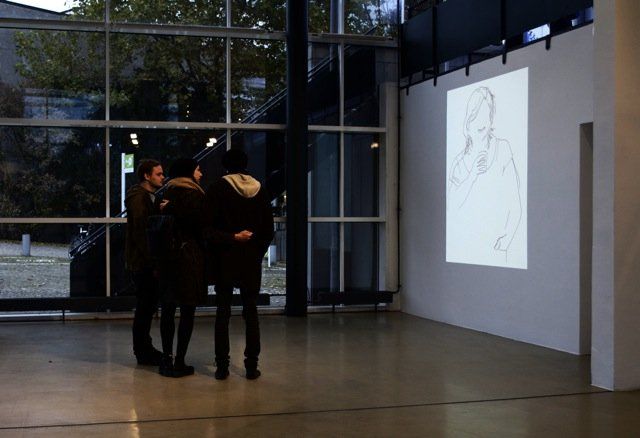Dringenberg - Projection
the first site specific installation of my drawings in the cellar of the castle of Dringenberg Bad Driburg 2014
Dringenberg-Projection
for the artistic intervention in the castle of Dringenberg, Bad Driburg (D) 2014
catalog text by Giulia Busetti
Heavy boots go down the stairs, exhausted but untiring down in the cellar.Then, cho- colate and chewing gum.
In May 1945 many people looked for a shelter from the bombs in the cellar of the stronghold in Dringenberg.Two of them are still there. On the wall of the same cellar were they spent the last three days of war, 15 ink drawings depicting two local inhabi- tants are projected. Between the last drawing and repetition of the first one, a pause. Like a story that is told.
Still from her first short films Shpresa Faqi uses the medium of the projector. In Dringenberg - Projections she assigns a new meaning to the projection. Thanks to their transformation in light drawings, the ink drawings appear like holograms and create a strong sense of presence.
The memories of the survivors collected by the artists are made visible.They keep the presence/absence dichotomy alive: they are there, they are not there, but they were there.
As spectators we feel present in the cellar of that time, in the place were the American soldiers observed the scene from. Involuntary witnesses, we are enraptured.The artists finds in the projection the most appropriate medium: a hanging painting had frozen the image giving us the time to perceive the actual absence.The meaning is bond to the medium, which creates a spatio-temporal turmoil through the harmony of form and content. This extreme case of sitespecificity finds its sense only here: the observers become privileged witnesses as part of the work.The concept, already important for the Minimalists, become here central topic.
As much important is the choice of the artist to draw both places and people in situ, which let her establish a direct relationship with the latter.The historical certification makes it an hyperrealistic work, not because it produces a photographic reality, but because it reaches an
extreme level of historical testament.
The memories are not necessarily aware, but organically incorporated in the structure of the self, feeding the actual observation.The lines, neither detailed nor photorealistic, but with intentionally visible corrections, are the result of second thoughts or callings into question, and
make the series of drawings documentary, but not photographic.
Faqi has always been interested in the exploration of the identity. Encouraged by her teacher Urs Lüthi, who often questioned the theme of the subjectivity letting the same subjects blend into different poses, the artist continues her recherches on the topic. Next to the subjects, also the identities of the places are depicted. Drawings of columns, arches and stairs represent a kinetic back and forth between what the civilian saw in the vaulted cellar and what the American soldiers faced when they gradually went down the stairs.
In this vaulted cellar under the Southern wing of the stronghold one perceives the com- plexity of the place: crossroad of epochs that shaped it, leaving the walls unaltered.The most ancient part of the Dingenberg stronghold, a place of protection of the citizens during World War II and place of projection of a story, as many other cellars. But this one has become something special thanks to the work of Shpresa Faqi, who created an indissoluble tie between art and the heterogenity of the history.





